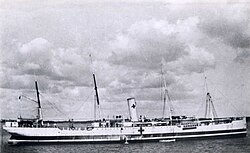Burma (ship, 1895)
|
As a hospital ship, around 1918
|
||||||||||||||||||||||||
|
||||||||||||||||||||||||
|
||||||||||||||||||||||||
|
||||||||||||||||||||||||
|
||||||||||||||||||||||||
|
||||||||||||||||||||||||
The Burma was put into operation in 1895 Transatlantic - passenger ship which in 1908 by the Russian shipping company Russian American Line for passenger traffic from Russia to New York was used. The ship, which had several names during its service and sailed under various flags , was sold to Russian and 1922 to German interests in 1914 and finally scrapped in Italy in 1924 .
background
The 4,595 gross registered tons (GRT) steamship was built at the Fairfield Shipbuilders yard in Govan near Glasgow and was launched on October 2, 1894 under the name Arundel Castle (III). The 126.49 meter long and 13.92 meter wide passenger and cargo ship was propelled by a triple expansion steam engine that developed 538 nominal HP (NHP) and allowed a cruising speed of 13 knots. The passenger capacity was 100 passengers in the first, 200 in the second and 1150 in the third class. The ship had a funnel, a propeller , four masts and four decks .
The Arundel Castle was built for the Castle Line ( Castle Mail Packet Company Ltd. ), a shipping company founded by Donald Currie in 1862, which operated passenger and freight traffic from Great Britain to India and later South Africa . The first steamers on this route were introduced in 1872. Due to strong expansion and a contract to transport Dutch mail , the Castle Line merged in 1900 with a competitor, the Union Line ( Union Steamship Company Ltd. ) founded in 1857 , to form the Union-Castle Line . The Arundel Castle remained after its maiden voyage in 1895 ten years the South Africa route on 16 February.
In 1905 the ship was sold to the Danish Det Østasiatiske Kompagni ( East Asiatic Company ), which renamed it Burma and used it in the Far East . In 1908 it was sold to the Russian American Line, a subdivision of the East Asiatic Company. Your first crossing on the new route from Libau to New York began to Burma on December 8, 1908, arriving in New York on 23 December. Stopovers on this route were Copenhagen , Boston and Halifax . On November 18, 1913, Burma ran for the last time for the Russian American Line in Libau.
Titanic incident
During this period the RMS Titanic sank on Monday, April 15, 1912 after colliding with an iceberg off Newfoundland . The three most widespread radio systems on merchant ships at the time were the brands Marconi , Telefunken and De Forest , the latter being used by Burma .
The Burma had left New York on April 11 in 1912 under the command of Captain Ludwig Stulping and steamed east to Rotterdam when the Titanic to 12:30 am (ship's time) the first distress signal sent. The Burma was at the time about 100 nautical miles southwest of the sinking site (position 41.46N., 50.14W) and recorded the radio message to 11:45 board time. One of the two radio operators in Burma , Joseph Cannon, immediately informed Captain Stulping, who had the following reply sent to the Titanic by the second radio operator Thomas Ward:
“We are 100 miles away from you and steaming at 14 knots. We'll be with you at 6:30 a.m. Position 40.48N, long. 52.13W. SBA "
The Burma changed its course to the Titanic to come to the rescue. Captain Stulping ordered additional heaters to the boilers and had stewards and stewardesses prepare food and sleeping places. In the following hours, the ship overheard radio messages from other ships in the area, including the NDL steamer Frankfurt and the Megantic and Baltic of the White Star Line . These radio messages revealed that the crew of the Titanic had given an incorrect position information in their distress signals.
The Burma arrived at the scene of the accident after daybreak, but found that the Titanic had sunk and the RMS Carpathia was already busy rescuing the survivors. From the bridge of the Burma of an iceberg was photographed from the contemporaries saw as likely that they were the iceberg that the Titanic had become fatal. The Burma continued its crossing to Rotterdam. The British passengers on board organized a funeral service for the victims of the Titanic , which took place on April 21. Since there was no British flag on board, one was quickly sewn.
Late years
Under the new name Mitawa (or Mitau or Mitava ), the steamer completed one last crossing from Libau via Copenhagen to New York in January 1914, before being launched in Kronstadt in August 1914 . During the First World War it was also used temporarily as the Russian hospital ship Mitava . In 1919 the ship briefly went back to the East Asiatic Company and was again called Burma .
In January 1921, the sale to the in carried Gdansk sedentary Polish American Line , for them as Józef Pilsudski shuttled from October 6, 1921 between Gdansk and New York. A short time later, in November 1921, the ship was confiscated and laid up in Kiel due to outstanding repair costs . The ship was sold to Germany in 1922 and scrapped two years later in Italy.
Web links
- Framework data and picture in the Clydebuilt Ships database
- Entry in TheShipsList as Arundel Castle (upper third)
- The Burma as part of the Titanic Inquiry Project
- The Burma in a collection of ships in radio contact with the Titanic were
- Further technical and historical data as well as pictures of the ship
- Illustrated report on Burma's involvement in the Titanic rescue operation
- Ludwig Stulping (1871-1934), captain of Burma
